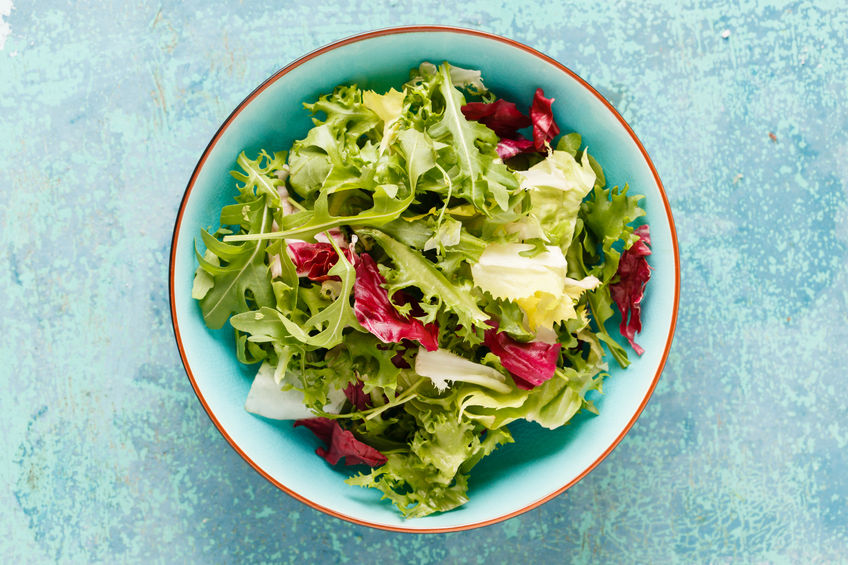By John Salak –
Everyone knows that having a big green, leafy salad is a healthy alternative to say a Whopper and fries. And they’re right. But not all salads are created equal. In fact, there’s a lot of stuff being tossed into salads that would be better off left out.
Let’s start with a salad’s foundation—a big leafy bed of something, usually lettuce. Unfortunately, there’s a lot to learn when it comes to picking the best lettuces or greens for a base. There are anywhere from 12 to 15 different types of lettuce and green leaves that can be used in a salad, which includes everything from the ubiquitous iceberg lettuce to the tony kale.
None of these are really high in calories, ranging from 6 to 45 calories a cup. But they differ a lot when it comes to nutritional value, all of which leave room for some argument over which is the healthiest green among them.
Everydayhealth.com, among others, ranks kale and spinach right at the top of the healthy salad list. Just one cup of kale, for example, supplies 19 percent of the daily recommended requirement (DRR) for Vitamin A, 23 percent for Vitamin C and a whopping 412 percent of Vitamin K. Besides tasting great, a cup a kale also provides 14 percent of a person’s DRR for calcium.
Spinach isn’t far behind, if at all, and actually may be more versatile than kale. It is a great source of iron and Vitamins A, K and C.
Other winners include beet greens (high in Vitamins A and K), swiss chard (high in fiber and Vitamins A, C and K), dandelion greens (high in calcium, iron and Vitamins C and B6), mustard greens (high in Vitamins C and K as well as folate) and collard greens (high in Vitamins C and K).
Watercress and Romaine also received thumbs up from everydayhealth.com. With watercress supplying a substantial portion of a person’s daily requirements for Vitamins K and C, while romaine offered up Vitamins A and K, antioxidants and folate.
Endives and radicchio were also cited as being a tasty ways to consume Vitamin K.
BusinessInsider.com lead the way is singling out iceberg lettuce and arugula as the least nutrition greens to toss into a salad. “Arugula’s distinct peppery taste doesn’t quite correlate with high nutritional content. While it does have some vitamins, it lacks other nutrients that other greens boast,” the site reported. It went on to add that “It’s no surprise that iceberg lettuce is among the least nutritious greens to put in a salad. In fact, Chick-fil-A has even banned the veggie from its stores, allegedly because of its low nutritional value.”
A great healthy salad doesn’t (or shouldn’t) end with a healthy green foundation. It must look and taste great and provide nutritional values that go beyond basic greens to include grains, proteins and veggies, according to heart.org.
The organization recommends adding raw vegetables like carrots, cucumbers, broccoli and cauliflower to add great crunch and color to a salad. It even suggested blending in roasted veggies like beets, potatoes and squash to add new flavor twists. For protein, heart.org advises tossing in skinless poultry like grilled chicken breast or salmon and tuna, which provide omega-3 fatty acids. Chickpeas, kidneys, navy or black beans and unsalted nuts, like peanuts, almonds and walnuts, provide additional nutritional benefits and give any salad an extra crunch.
Grains, arm or cold cooked, also strengthen a salad. Consider whole wheat couscous, barley, quinoa, bulgur or wild rice.
Salads can be turned up a notch higher by including edamame, which is high in fiber, iron, magnesium, manganese, phosphorus, thiamin, folate and vitamin K, lifehack.com suggests.
Another possible ingredient is seeds—sunflower, chia, sesame, pumpkin, flax and pomegranate—which lifehack.com reports provides a “big dose of fiber, omega-3’s and protein for very little caloric intake.” And, of course, don’t forget to add avocado, which contains 20 essential vitamins, minerals and phytonutrients.
Now, all that’s left is the dressing. Forget about the creamy ranch or that wonderful blue cheese offering. Don’t ruin a good (and healthy) salad by smothering it with a high-fat, heart-stopping topping. Stick to oil and vinegar. It is healthy and tasty and can be spiced up further by adding fresh herbs, onions, garlic and scallions.












